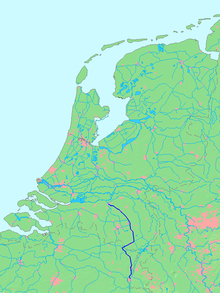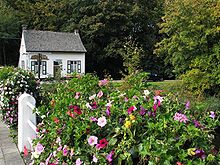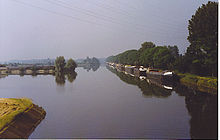Zuid-Willemsvaart
The Zuid-Willemsvaart is a canal in the Netherlands and Belgium . It is used to shorten the route across part of the Meuse , namely between Belgium and the part of the river that forms the border between the Dutch provinces of Noord-Brabant and Gelderland . It connects the cities of Maastricht and 's-Hertogenbosch .
course
The canal has its beginning in the Dutch province of Limburg in the city of Maastricht. It then runs through the Belgian province of Limburg and, south of the municipality of Weert, again reaches Dutch territory in the Dutch province of Limburg. The last section of the canal runs through the province of Noord-Brabant. At Bocholt he takes up the Kempen Canal .
The length of the canal is approximately 123 km. Coming from Maastricht, it leads through the Belgian cities and municipalities Smeermaas , Lanaken , Maasmechelen , Dilsen-Stokkem , Maaseik , Bree and Bocholt as well as Weert , Helmond , Beek en Donk , Veghel , Bernheze and Sint-Michielsgestel in the Netherlands.
history
In the course of military considerations, Emperor Napoleon decided to improve transport over water in the Netherlands and Belgium. Even before the Zuid-Willemsvaart was built, there was a water connection between Maastricht and 's-Hertogenbosch, namely across the Maas. However, this runs in a large curve south of Nijmegen . In addition, it was only navigable for five months a year and had several shallows where navigation was impossible.
In 1822 , King William I of the Netherlands, which at that time included what is now Belgium, decided to build a canal between Maastricht and 's-Hertogenbosch, which was named Willemsvaart. But since a canal called Willemsvaart (today's Noord-Willemskanaal ) was built in the province of Drenthe later, the word Zuid (south) was added to the name. Construction of the canal began in 1823 ; just three years later the canal was completed.
During its 123 km run, the canal negotiates a height difference of 40 meters. 21 locks were built for this purpose . The cost of building the canal, which was dug by hand without major technical aids, amounted to 4.45 million guilders .
The part of the canal that was in the center of Maastricht and south of it was filled in during the construction of the Maasboulevard in the 1860s. Since then, the beginning of the canal has been north of Maastricht city center.
Projects
The Zuid-Willemsvaart between Maas and Veghel has been included in the National Traffic and Transport Plan (NVVP) as part of the main inland waterway network. This means that the canal must be suitable for inland vessels of class IV (up to 1350 tons). At present the Zuid-Willemsvaart runs from Den Dungen through the center of 's-Hertogenbosch and then flows into the Meuse. On this section, the canal is only suitable for class II barges (up to 600 tons) and is therefore navigable to a limited extent.
In 2007 , work began on eliminating this bottleneck by digging a new junction at Den Dungen. The new run is planned along the A2 motorway , between 's-Hertogenbosch and Rosmalen in the direction of the Meuse. However, this does not mean that the Zuid-Willemsvaart will disappear from the cityscape of 's-Hertogenbosch. The old barrel will remain, but will no longer be used for commercial inland shipping. The work was completed in 2014 together with the widening of the A2 motorway.
Web links
- Zuid-Willemsvaart ( Dutch ) ( Memento from August 25, 2005 in the Internet Archive )
- Webpage of the Dutch Ministry of Transport about the Zuid-Willemsvaart ( Dutch ) ( Memento of February 21, 2006 in the Internet Archive )



